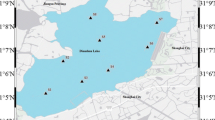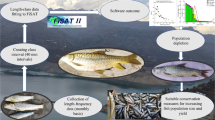Abstract
Length-frequency data of Nile tilapia (Oreochromis niloticus) was studied using 1250 specimens of both sexes combined with maximum length and weight of 44.5 cm (TL) and 1050 g respectively through gill net catch at different landing sites of Halali Reservoir, Madhya Pradesh. The data were grouped into classes of 10-mm intervals and various parameters of population dynamics of fish were analysed and computed using the FiSAT-II software package (FAO-ICLARM Stock Assessment Tools). The length-weight parameters were found to be at W = 0.001 L 2.96 where b = 2.96 and a = 0.001. Growth parameters L∞ and K of the species were L∞ = 46.73 cm and K = 0.63/year respectively; the annual rates of natural (M) and fishing mortality (F) were found to be 0.60 and 0.72 respectively. The estimated values for the exploitation rate (E) using the length-converted catch curve and virtual population analysis were 0.54 and 0.42 respectively. The recruitment pattern shows that O. niloticus was recruited in the fishery during April with one peak. Based on the data analysis, the stock in the Halali Reservoir does not exceed the maximum fishing pressure (Emax = 0.55) and there is selective mortality towards adult fish sizes. The introduction of Nile tilapia improved the total catch per unit of effort (CPUE), as well as increased the number of active fishers. Conversely, a significant reduction in the CPUE of other commercially important indigenous species was observed after the introduction of Nile tilapia in the reservoir. Therefore, for management purpose, this study suggests that the existing effort in terms of gill net mesh size which target size (TL—15.0 to 25.0 cm) individuals of length group is to be increased to exert more fishing pressure on Nile tilapia population in the reservoir to decline its abundance in the long term.










Similar content being viewed by others
References
Ahmed KKU, Amin SMN, Haldar GC, Dewan S (2003) Population dynamics and stock assessment of Oreochromisniloticus (Linnaeus) in the KaptaiReservoir, Bangladesh. Indian J Fish 50:47–52
Attayde JL, Brasil J, Menescal RA (2011) Impacts of introducing Nile tilapia on the fisheries of a tropical reservoir in North-eastern Brazil. Fish Manag Ecol 18:437–443
Balirwa JS (1992) The evolution of the fishery of Oreochromisniloticus (Pisces: Cichlidae) in Lake Victoria. Hydrobiologia 232:85–89
Bbole I, Katongo C, Deines AM, Shumba O, Lodge DM (2014) Evidence of hybridization between non-indigenous Oreochromis species in the lower Kafue River and its potential impacts on fishery. J Ecol Nat Environ 6(6):215–225
CIFRI Bulletin No. 117 (2003) Ecology & Fisheries of selected reservoirs in Tamilnadu:1–33
De Silva SS, Subasinghe RP, Bartley DM, Lowther A (2004) Tilapias as alien aquatics in Asia and the Pacific: a review. FAO Fish Tech Pap 453:65
Dwivedi AC, Mayank P, Imran S (2016) Reproductive structure of invading fish, Oreochromisniloticus (Linnaeus, 1757) in respect of climate from the Yamuna river, India. J Sci Achiev 4(2):164
Dwivedi AC, Jha DN, Das SCS, Mayank P (2017) Population Structure of Nile Tilapia, Oreochromisniloticus (Linnaeus 1758) From the Ken River, India. JSciAchiev 2(5):23–27
Ganie MA, Mehraj DB, Mohd IK, Muni P, Balkh MH (2013) Invasion of the Mozambique Tilapia, Oreochromismossambicus (Pisces: Cichlidae; Peters, 1852) in the Yamuna River, Uttar Pradesh, India.J. Ecol Nat Environ 5(10):310–317
Global Invasive Species Database (2020) Species profile: Oreochromisniloticus. Downloaded from http://www.iucngisd.org/gisd/speciesname/Oreochromis+niloticus on 20-01-2020
Gulland JA (1969) Manual of methods for fish stock assessment. Part 1. Fish population analysis. Fishery Resources and Exploitation Division. FAO, Rome, p 154
Gulland JA (1987) Length-based methods in fisheries research: from theory to application. In: Pauly D, Morgan RG (eds) Length based methods in fisheries research. ICLARM Conf. Prod., Manila, pp 335–342
Haddon M (2011) Modeling and quantitative methods in fisheries. Champan & Hall, London, p 449
Jayaram KC (1981) The fresh water fishes of India. ZSI, Kolkata, pp 1–438
Jayaram KC (1999) The fresh water fishes of the Indian region. Narendra Publishing House, Delhi, p 551
Jere A, Chama L, Stanford S (2019) Assessing the potential presence and impact of Nile tilapia, Oreochromisniloticus (Pisces: Cichlidae; Linnaeus 1758) in Mutukutuku reservoir in Solwezi, Zambia. J Food Sci Eng 9:385–395
Kumari S, Sandhya KM, Karnatak G, Lianthuamluaia, Sarkar UK, Panda D, Mishal P (2019) Length-weight relationship and condition factor of Gudusiachapra (Hamilton, 1822) from Panchet Reservoir, Jharkhand, India. Indian J Fish 66(3):136–139
Lakra WS, Sarkar UK, Kumar RS, Pandey A, Dubey VK, Gusain OM (2010) Fish Diversity, Habitat Ecology and Their Conservation and Management Issues of a Tropical River in Ganga Basin, India. Environmentalist 30(4):306–319
Lamarque P, Therezien Y, Charlon N (1975) Etude des conditions de pieche a lelectricitedans les eauxtropicales. 1 Estudesconduites a Madagascar et ev. Zambie (1972). Bull Hundred Study Rech Sci Biarritz 10(3):403–554
Li S (1998) Genetic characterization of major freshwater culture fishes in China. Shanghai Scientific and Technical Publishers, Shanghai, p 233
Mehak A, Mu Y, Mohsin M, Noman M, Nazir K (2017) Population dynamics of Nile Tilapia (Oreochromisniloticus) at Chashma Barrage, Pakistan. Indian J Mar Sci 46(1):206–210
Naeem M, Gillani A, Salam Q, Ishtiaq A (2010) Length-weight relationships of Notopterusnotopterus and introduced Oreochromisniloticus from the Indus River, southern Punjab, Pakistan. JApplIchthyol 26:620
Pauly D (1983) Some simple methods for the assessment of tropical fish stocks. FAO Fish Tech Pap 234:52
Pauly D, Soriano ML (1986) Some practical extensions to Beverton and Holt’s relative yield-per-recruit model. In: Maclean JL, Dizon LB, Hosillos LV (eds) First Asian fisheries forum. Asian Fisheries Society, Manila, pp 149–495
Sreenivasan A (1967) Tilapia mossambica: its ecology and status in Madras state, India. Madras J Fish 3:33–39
Talwar PK, Jhingran AG (1991) Inland Fishes of India and Adjacent Countries, vol I & II. Oxford and IBH Co., Pvt. Ltd., New Delhi
Thompason WF, Bell FH (1934) Biological statistics of the pacific halibut fishery, effect of changes in intensity upon total yield and yield per unit of gear. Rep Int Fish (Pacific halibut) Comm 8:49
Witte F, Goldschmidt T, Wanink J, Oijen MV, Goudswaard K, Witte-Maas E, Bouton N (1992) The destruction of an endemic species flock: quantitative data on the decline of Haplochromine cichlids of Lake Victoria. Environ Biol Fish 34:1–28
Yamaguchi Y, Hirayam N, Koike A, Adam HA (1990) Age determination and growth of Oreochromisniloticus and Sarotherodongalilaeus in high dam lake, Egypt. Nippon Suisan Gakkaishi 56:437–443
Yousuf T, Ibrahim M, Majid H, Ahmad J, Vyas V (2012) Ichthyofaunal Diversity of Halali Reservoir, Vidisha, Madhya Pradesh. Int J Sci Res Publ 2(12):1–7
Acknowledgements
The authors are grateful to Madhya Pradesh Fisheries Federation (Cooperative) Limited for their help during sampling, and we express our sincere gratitude to Director ICAR-CIFRI for giving continuous support and encouragement.
Funding
This study was funded by Madhya Pradesh Fisheries Federation (Cooperative) Limited.
Author information
Authors and Affiliations
Corresponding author
Additional information
Responsible Editor: Philippe Garrigues
Publisher’s note
Springer Nature remains neutral with regard to jurisdictional claims in published maps and institutional affiliations.
Rights and permissions
About this article
Cite this article
Johnson, C., Sarkar, U., Koushlesh, S.K. et al. Population structure of Nile tilapia and its impact on fisheries of a tropical impacted reservoir, Central India. Environ Sci Pollut Res 27, 29091–29099 (2020). https://doi.org/10.1007/s11356-020-09234-w
Received:
Accepted:
Published:
Issue Date:
DOI: https://doi.org/10.1007/s11356-020-09234-w




